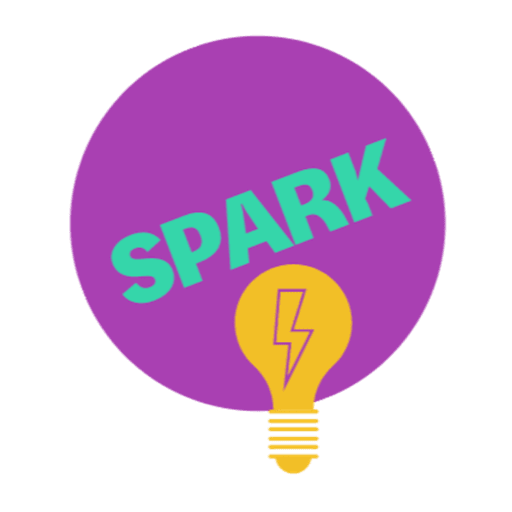Racism in the workplace doesn’t always come in obvious forms. It’s not always as clear-cut as slurs or overt exclusion, though those still happen. More often, it shows up in quieter, harder-to-name ways: a colleague who keeps their distance or rolls their eyes when you raise an issue, the promotion that never comes, or the meeting where your idea is ignored until someone else repeats it.
These moments are often overlooked, but their impact runs deep. They can erode confidence, take a toll on mental health, and shape entire career paths. This harm is compounded by the roles that racialised people are expected to play at work, the exclusion they experience, the stereotypes they encounter, and racial inequity at a broader, systemic level.
To understand more about how this harm shows up in workplaces in 2025, we invited racialised people working across sectors to share their experiences of bias, discrimination and racism at work. This work is part of our partnership with Sistren Legal Collective. Together, we’re working to understand the lived experiences of workplace-based racial harm among people and the support they need or may want.
Through open and closed questions, respondents generously, honestly, and courageously shared their stories, often revealing personal and painful experiences. The message that came through was loud and clear: racism in the workplace is not unusual. It is widespread, systemic, and often ignored or normalised. This blog shares what we learned; what follows is a mix of our in-house analysis, statistical insight and personal accounts.
These stories have deeply resonated with us, and the reason why most of us find ourselves in this work is because of previous experiences of racial harm. We are here because of the experiences that have shaped us, and we choose to turn that pain into power and support marginalised communities who are often isolated, excluded, or left out of the conversation.
Every single story shared with us will contribute to creating a practical, uplifting, and lived-experience-informed Legal Toolkit for individuals experiencing racism at work.
We want to acknowledge the individuals who shared their responses and trusted us with their stories, and we hope this helps others feel seen and less alone.
1. Who Took the Survey
1.1. Employment and Work Context
We heard from 60 people working across a broad range of sectors and employment types. Their stories reflect the complex ways racism intersects with job roles, contract types, and organisational structures.
- Employment: The majority of respondents (54%) were full-time employees, while others worked part-time (22%) or as sole traders, freelancers, or consultants (17%). The rest were students or seeking work.
- Sectors: Responses came from diverse sectors, notably education (18.6%), health and social care (16.9%), finance (10%), and arts and culture (8.5%). The largest group (20%) selected “Other sector.”
- Workplace size: Respondents worked across all organisation sizes – from sole traders and micro-entities (15.3%) to small (16.9%), medium (20%), and large organisations (37.3%, 250+ staff).
- Tenure: Participants’ experiences ranged widely, although most had been in their current roles for between 1 and 5 years.
Table 1: Employment and Work Context of Survey Respondents
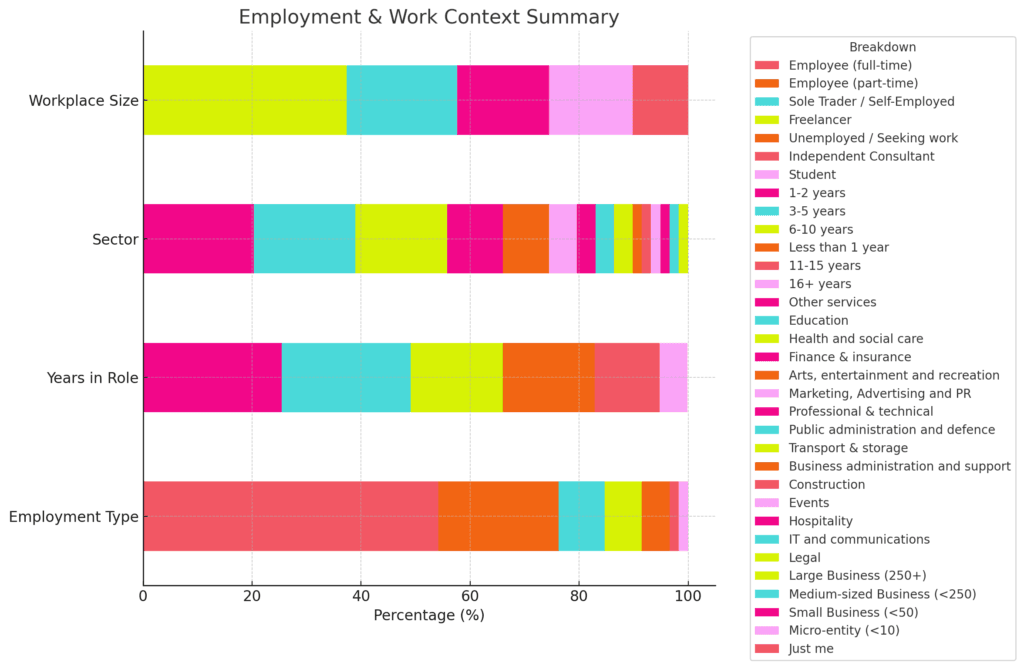
1.2. Demographic Data
- Ethnicity: Respondents identified as Black / African / Caribbean / Black British (35.6%), South Asian (30.5%), Mixed or Multiple heritage (23.7%), and East and South-East Asian (5.1%).
- Gender: The majority were women (83%), followed by men (11.9%), and gender-expansive individuals (3.4%).
- Sexual orientation: Most identified as heterosexual (66%), with strong representation from the LGBTQIA+ community (27%).
- Age: Respondents spanned a wide age range, with the largest groups aged 26–35 (37.3%), 36–49 (37.3%), and 50–59 (18.6%).
- Disability and health: 20% reported a mental health condition, 18.6% a long-term health condition, and 13.6% a cognitive or physical disability.
- Religion: Respondents reported a range of faiths, with the largest groups identifying as having no religion (32%), Christian (30.5%), Muslim (18.6%), Hindu (5.1%), and Sikh (3.4%).
- Education background: Most attended state schools (68%), while others went to schools outside the UK (14%) or fee-paying schools (10%), with 5.1% receiving bursaries or scholarships to attend fee-paying schools.
Table 2: Demographic Data of Survey Respondents
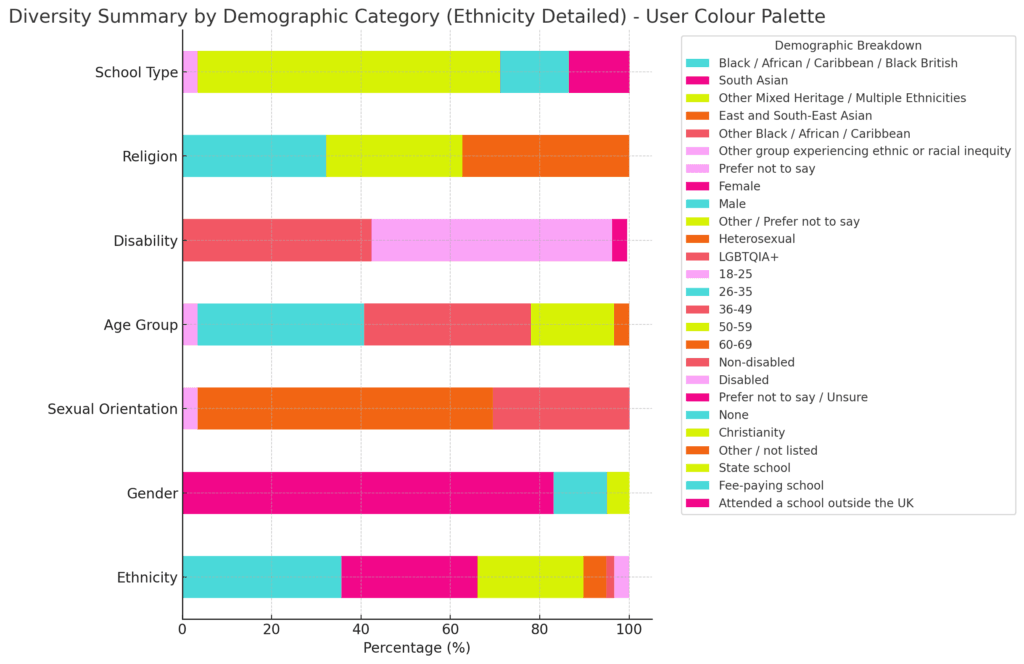
2. What the Survey Showed Us: Racism at Work Is an Interconnected System, Not an Isolated Incident
2.1. A Three-Way Relationship: The Interlocking Systems of Racial Harm at Work
One of the strongest findings that emerged from our survey was this: racism at work is not just about isolated comments or individual experiences. It’s part of a wider system—one that operates on multiple, interconnected levels.
The stories and insights we gathered revealed a clear three-way relationship that helps us understand how racial harm is created, sustained, and internalised in the workplace. These findings underscore the deep, pervasive impact of racism and intersecting forms of discrimination in the workplace.
There is a clear connection between organisational and institutional practices, broader societal and systemic inequalities, and individual experiences. These levels do not operate in isolation; instead, they reinforce and sustain one another. To truly understand the nuance of how racism manifests and persists in the workplace, we must consider all three dimensions together.
Table 3: The Interlocking Systems of Racial Harm at Work
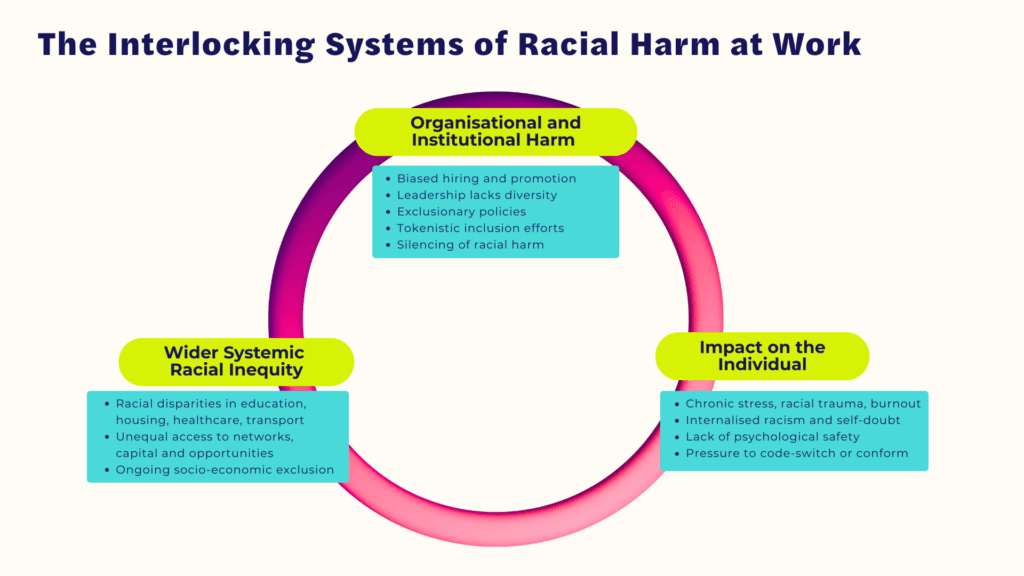
2.2. Interconnecting System: Organisational / Institutional Harm
Many workplaces reinforce racism through their internal structures, policies, and cultures. Respondents highlighted:
- Biased recruitment and promotion: Hiring based on “cultural fit” excludes racialised candidates, while white staff are favoured for promotion even when others are equally or more qualified.
- Lack of representation in leadership: Senior roles remain largely white, with racialised staff stuck in junior, lower-paid or fixed-term roles with limited progression.
- Exclusionary policies and practices, including dress codes, communication norms, and disciplinary procedures, often unfairly impact racialised staff.
- Tokenistic inclusion efforts: Diversity panels and working groups often exist without real power, budget, or support to drive meaningful change.
- Silencing of racial harm: Microaggressions and racism go unchallenged, while those who speak up face gaslighting, retaliation or are labelled “difficult”.
Many workplaces, by design, were not built with racialised people or those from marginalised backgrounds in mind. From organisational culture to structural policies, the norms that shape professional environments often reflect and prioritise white, middle-class experiences, leaving others to navigate exclusion, bias, and barriers to progression.
This misalignment creates environments where functioning becomes the focus, rather than thriving or progression. In Section 3, we’ll explore this more deeply, examining how workplace structures, expectations, and cultures often fail to support, protect, or uplift racialised staff.
2.3. Interconnecting System: Broader Society and Systems
Workplaces don’t exist in a vacuum. They reflect and replicate the racial inequalities that exist in broader society. The workplace is not separate from wider societal injustice – it’s part of it. Broader systemic racism, across education, housing, healthcare, and access to wealth or networks, determines who enters the workforce, who advances, and who is seen as credible or professional. These long-standing inequalities create unequal starting points that employers often overlook.
Respondents made it apparent how external systemic racism shows up at work:
- Racial disparities in education, housing, healthcare, and transport: These inequities shape who even makes it into the workforce, who thrives, and who is seen as “professional” or “capable.”
- Unequal access to networks, capital, and recognition: Racialised people are often excluded from informal networks, sector events, or social spaces where relationships and opportunities are formed. Access to support, such as mentorship, insider networks, and informal opportunities, was an area of inequity. More than half of the respondents said they rarely or never have access.
- Historical and ongoing socio-economic exclusion: Generational wealth gaps, immigration barriers, and structural racism in public services all contribute to unequal starting points, which organisations too often ignore.
Systemic issues don’t disappear at the office door. They also show up in how racialised employees are expected to behave, respond, or share their views at work, often under unspoken rules shaped by power, whiteness, and institutional norms.
The data highlights a persistent reality: for many racialised people, navigating conversations about race, identity, and politics at work is not only uncomfortable – it’s a source of ongoing emotional strain.
Table 4: Impact of Political and Social Issues on Employees and Workplace Dynamics
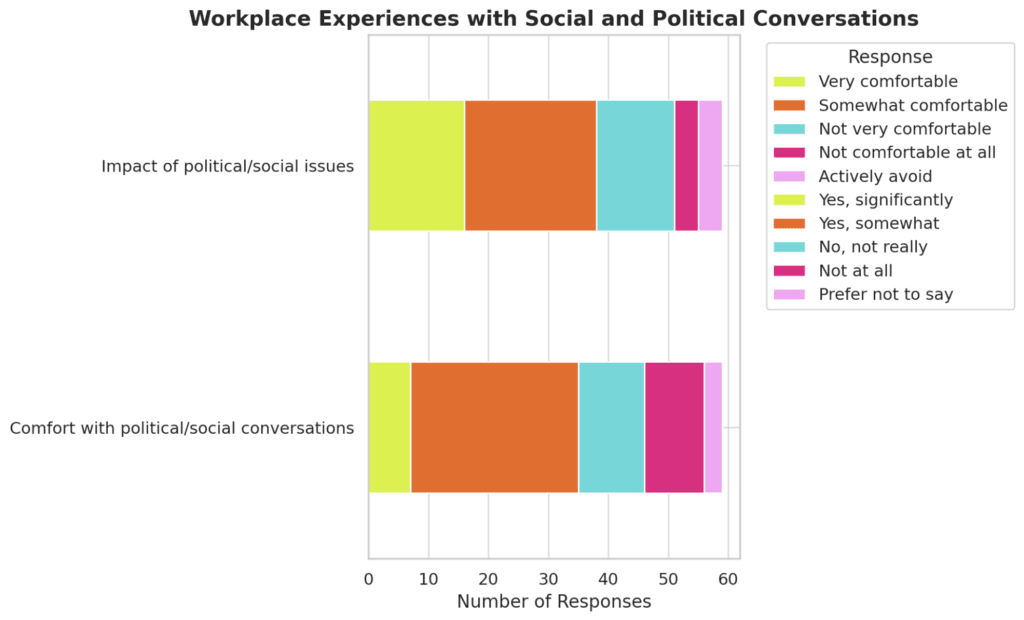
- Comfort Levels: Almost half of the respondents (47.5%) said they felt somewhat comfortable engaging in conversations about political and social issues. More than a third reported discomfort – 18.6% felt not very comfortable, 16.9% said they were not comfortable at all. A further 5.1% said they actively avoid these discussions. This points to a lack of psychological safety, especially for those who are more likely to be directly affected by these issues.
- Impact of Current Events: Broader political and social issues, particularly around race, immigration, and identity, are not separate from workplace culture. Nearly two-thirds (64.4%) of respondents reported that these issues have had a somewhat or significant influence on their experience of the working environment. 22% said these topics had no real impact. This shows how external injustices continue to shape internal workplace dynamics.
Table 5: The Pressure to Speak Up or Stay Silent
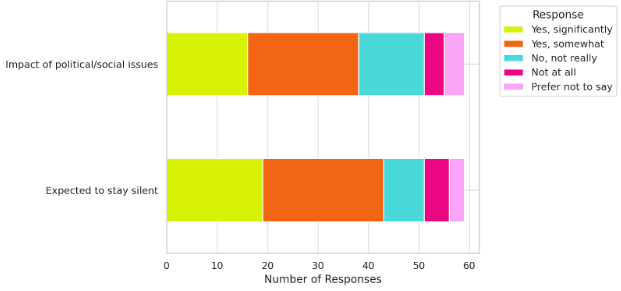
- The Pressure to Speak Up: A striking 71.2% of respondents reported feeling somewhat or significantly expected to share their views on issues such as race and identity at work. For many racialised staff, this translates into a burden of emotional labour – being expected to represent an entire group, relive traumatic experiences, or act as an educator, often without support or recognition.
- The Pressure to Stay Silent: At the same time, 72.9% reported feeling somewhat or significantly expected to stay silent. This contradiction, expected to speak, and yet also to know what topics are out of bounds, reflects the emotional tightrope many racialised workers find themselves on.
These findings show how wider political and social issues around race and identity shape workplace culture, leaving racialised staff feeling impacted and unsafe. Many felt pressure to stay calm and high-performing, even as racism and harmful comments were tolerated, creating emotional strain and silence.
“We’re told to keep politics out of work – but when someone shares racist misinformation, that’s allowed.”
Survey Respondent
You’re expected to be the race expert until you mention racist incidents.
Survey Respondent
I still have to deal with the systemic racism outside of my workplace and from clients, etc.
Survey Respondent
2.4. Interconnected System: The Human Impact on Individuals
Ultimately, it is individuals who carry the emotional, psychological, and professional burden of these interlocking organisational and systemic harms. Our respondents described a range of personal consequences.
- Chronic stress, racial trauma, and burnout: The cumulative toll of racism at work was significant. Many respondents described experiencing anxiety, depression, burnout, and long-term mental health struggles because of their workplace experiences:
- 44.1% said racism significantly affected their mental health and wellbeing
- 30.5% reported a moderate impact.
- Internalised racism and self-doubt: Being regularly undermined or overlooked leads some racialised staff to question their own worth or capabilities, even when they know they’re highly competent.
- Lack of psychological safety: Many felt unsafe sharing concerns, contributing honestly in meetings, or bringing their whole selves to work, fearing backlash or exclusion.
- Pressure to code-switch or conform: Racialised staff often feel the need to alter their appearance, accent, or communication style to be seen as “professional” or to avoid being stereotyped.
I have had to leave a job due to experiencing racism, sexism and maternity discrimination. I was signed off for 6 months and am still recovering from the mental health impact 2 years later.
Survey Respondent
I had a panic attack on the train home. I was signed off for six months, and I’m still recovering.
Survey Respondent
The counselling they gave me ran out. But the person who harmed me is still at work.
Survey Respondent
The CEO shut me down in a staff meeting, and I raised concerns around staff burnout, especially for staff of colour.
Survey Respondent
3. Experiences of Discrimination at Work
3.1. All too Common, and Compounded
The findings on racism at work were striking. A vast majority of respondents (84.7%) said they had experienced racism indirectly (for example, stereotypes, micro-aggressions, or noticing patterns of unfair treatment). Nearly half (49.2%) reported experiencing direct racism themselves (such as being the target of overt and explicit racist behaviour, language, or decisions). These numbers highlight just how widespread and normalised racial harm remains in many workplaces.
Racism didn’t just come in one form. It was multifaceted and compounded by other prejudices; a notable proportion of respondents had also experienced anti-Blackness, misogyny, ageism, ableism, colourism, and Islamaphobia.
Black respondents described being held to higher standards than white or even other racialised colleagues. They faced disproportionate scrutiny, felt pressure to conform to stereotypes, and were often overlooked or distrusted in decision-making processes. Anti-Blackness was described as both personal and structural, shaping who was promoted, who was trusted, and whose voices were heard.
Table 6: Experiences of Discrimination at Work
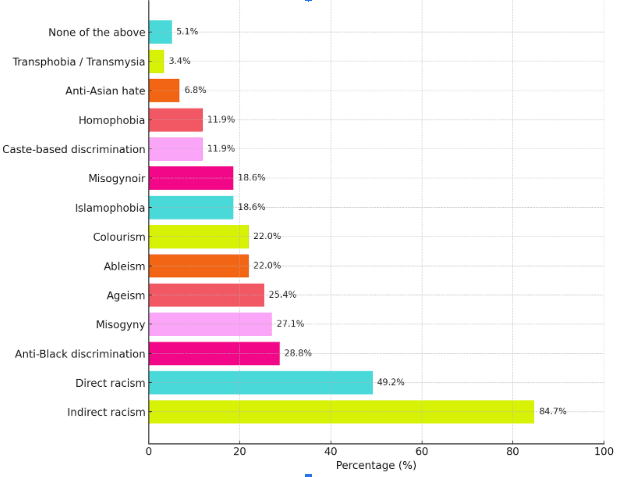
On my first day, someone sprayed air freshener in my office. Later, my manager said a complaint had been made about my body odour.
Survey Respondent
My manager kept calling me by the name of another Asian woman in the office.
Survey Respondent
Someone described me as a ‘strong Black woman’ like it was a compliment – but it meant I wasn’t allowed to be vulnerable.
Survey Respondent
I’m compared to my Asian colleagues, like I should be quieter or more compliant. But I’m just being me.
Survey Respondent
I was infantilised because I look younger than I am. Add in race and disability, and I was constantly dismissed.
Survey Respondent
I’m Muslim, and the Islamophobia wasn’t just about my hijab – it was about assumptions of who I am.
Survey Respondent
I’ve experienced endless racism and discrimination in all work places besides my current ones. This ranges from overt racism – slurs, comments on my hair, overt exploitation – to more subtle forms of discrimination.
Survey Respondent
3.2. Impact on Career Growth and Personal Paths
Respondents shared insights about how racism and other forms of discrimination impact them. These experiences shape career pathways and choices, as well as day-to-day roles and tasks, and have a longer-term impact on wellbeing and mental health.
- Career Impact: 68% said their racial or ethnic background negatively affected their progression, while only 6.8% reported any positive impact.
- Unequal Standards: Many felt they had to work harder than white colleagues to be recognised, yet were often overlooked or excluded from strategic roles.
- Forced Exits: 54.2% have left a job due to racism; others stayed in harmful roles due to financial need or commitment.
- Work Distribution: 47.5% said people from their racial or ethnic background are consistently given different types or amounts of work.
- Intersecting Barriers: 72.9% said other aspects of identity, like gender, disability or class, also negatively shaped their workplace experience.
- Mental Health: 44.1% said racism significantly harmed their wellbeing, with a further 30.5% reporting a moderate impact, showing the need for better support.
Table 7: Impact on Career Growth and Personal Paths
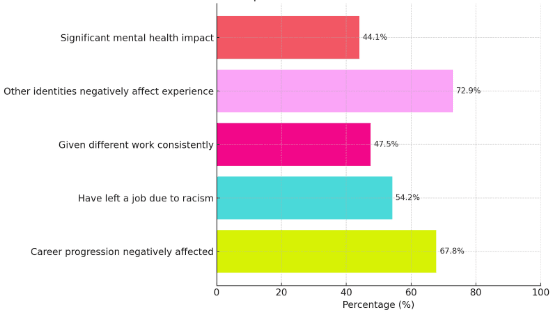
I’ve had to work twice as hard to be seen as competent – and even then, promotions go to white colleagues.
Survey Respondent
I was excluded from strategic meetings despite being the most experienced person in the room.
Survey Respondent
I stayed because I cared about the mission. But it cost me my health and confidence.
Survey Respondent
I’ve witnessed race-based bullying. I’ve been excluded due to my race. I’ve seen people leave due to a culture of prejudice.
Survey Respondent
3.3. Perceptions and Experiences of Employers
When it comes to how racialised employees perceive their employers, a twofold pattern emerges. On one hand, many view organisational approaches to race and inclusion as tokenistic and extractive – more about optics than meaningful change. On the other hand, there is a profound lack of trust, safety, and confidence in HR and leadership to handle discrimination or harm effectively.
These two issues are distinct, but closely linked: when inclusion efforts feel performative and support systems lack credibility, it reinforces a workplace culture that fails to protect, value, or empower those most affected by inequality.
- Extraction: Over 70% had been asked to represent their race, ethnicity, or culture in ways that felt tokenistic, and 44% felt their organisations’ diversity and inclusion efforts were largely symbolic, with little real change. Only 15% felt those efforts genuinely improved racial equality.
- Trust and Confidence: Alongside these findings, respondents expressed low trust and confidence in their organisations’ ability to address discrimination effectively, with average ratings around 3.6–3.8 out of 5 for HR and leadership.
- Formal reporting routes are widely distrusted: Many respondents turned to informal channels or external support because internal HR systems were seen and experienced as ineffective or biased.
- Lack of Safe Pathways: One of the most striking themes from the survey was how many racialised workers felt let down or retraumatised by formal systems, especially when they tried to speak up about racism at work. From being ignored or dismissed by HR to signing NDAs (Non-Disclosure Agreements) under pressure, respondents described feeling isolated, disempowered, and uncertain about their legal rights.
- Retaliation: Those who raised concerns about racism or bullying were often punished rather than protected. Retaliation included being shut down in meetings, denied opportunities, or being managed out of their roles entirely.
After raising concerns about racism within my workplace, I became the target of sustained bullying, harassment, and exclusion. Rather than addressing the issues I highlighted, leadership and colleagues responded by isolating me, undermining my work, and questioning my credibility.
Survey Respondent
I flagged bullying and racism to HR. Nothing happened – except that I was managed out.
Survey Respondent
After I raised burnout concerns for staff of colour, I was labelled ‘disruptive’ by leadership.
Survey Respondent
I took an NDA I didn’t fully understand – just so I could leave quietly.
Survey Respondent
I raised a grievance when I resigned. HR ruled against me, even though they said they’d coach the other person.
Survey Respondent
I challenged my employer and took an NDA with provisions I regret. I still don’t fully know if they were legal.
Survey Respondent
After I raised a grievance, I was told to ‘be the bigger person.’ HR acknowledged there was harm but still ruled against me.
Survey Respondent
4. Listening Isn’t Enough. We Need Change.
This survey confirms what many of us already know but struggle to voice: racism at work is everyday, structural, and damaging. It’s not limited to one sector or role. It shows up in HR policies, leadership decisions, office culture, and informal power structures. Your insights replicated the patterns we see in broader society, which are often overlooked. But this isn’t just about awareness. It’s about accountability. Organisations must go beyond surface-level inclusion efforts and move towards building and creating a culture of belonging, where workers feel seen, heard, and valued.
If we want workplaces where people are not just present, but respected, safe, and able to thrive, we must be willing to acknowledge the harm and act on it. These stories aren’t just anecdotal – they’re systemic. And they point to a clear need: accessible, trauma-informed legal guidance for racialised people navigating discrimination at work.
4.1. The Legal Toolkit
That’s why we’ve partnered with Sistren Legal Collective to co-create a Legal Toolkit. This will be a practical, community-led resource to help racialised workers understand their rights, navigate complex processes, and make informed decisions—whether they choose to speak up, walk away, or take legal action.
The (anonymised) findings will directly inform the toolkit of this survey. We’re using the information you shared, including your stories, frustrations, questions, and hopes, to shape the content and priorities of the toolkit.
We will explore how to include:
- Clear explanations of available legal protections, employment, and equality law
- What to expect from grievance procedures and HR investigations
- Signposting practical tools and resources
- Guidance on when to seek legal advice and alternatives to legal routes.
This won’t be a dry legal manual. It will be co-created with lived experience at the centre – and rooted in care, transparency, clarity, and solidarity, with a message of hope, that we have more power than we give ourselves credit for. We intend to publish the Legal Toolkit before the end of the year.
4.2. Accessing Support
If you are experiencing discrimination at your workplace, here are some initial resources you can refer to:
- Spark Racial Justice Support Hub: Resources, articles, guides, and singposting to services.
- Spark Insights: Anti-racist training and coaching collective providing bespoke support to organisations and individuals working in the third sector and wider social impact sector.
- ACAS: ACAS provides employees and employers with free, impartial advice on workplace rights, rules, and best practices.
- Citizens Advice: Guidance on deciding what to do about discrimination at work.
- Mind has a list of useful contacts and guidance for people affected by racism and its impact on mental health.
- TUC: TUC is the UK’s trade union body offering advice on workplace rights. This blog guides you on what to do if you encounter racial discrimination at work.
- Consider talking to a GP if you are experiencing a decline in your mental health due to workplace discrimination.
Glossary
Ableism
Discrimination and social prejudice against people with disabilities. This includes barriers to access, exclusion, and harmful assumptions. Disability is a protected characteristic under the Equality Act 2010.
Ageism
Discrimination or stereotyping based on a person’s age often unfairly targets older or younger individuals. This is a protected characteristic under the Equality Act 2010.
Anti-Asian Hate
Racism and violence targeting people of East, South, or Southeast Asian descent. This includes verbal abuse, social exclusion, and physical attacks. Covered under racial discrimination in the Equality Act 2010.
Caste-based Discrimination
Unequal treatment or prejudice based on caste. Though not explicitly named in UK law, such discrimination can fall under race in the Equality Act 2010, particularly where caste is linked to ethnic origin.
Colourism
A form of prejudice or discrimination where people are treated differently based on the shade or tone of their skin, often within the same racial or ethnic group. Lighter skin is usually privileged over darker skin. Not referenced explicitly in the Equality Act 2010, but it may fall under racial discrimination depending on the context.
Direct Racism
When someone is treated less favourably explicitly because of their race, ethnicity, or nationality, under the Equality Act 2010, this is unlawful racial discrimination.
Indirect Racism
When a policy or practice applies to everyone but disadvantages people from a particular racial or ethnic group, without a justifiable reason.
Islamophobia
Discrimination, hostility, or prejudice directed at Muslims or those perceived to be Muslim. It includes stereotyping, hate speech, exclusion, and violence. Protected under the Equality Act 2010 as part of religious discrimination.
Micro-entities
Small businesses or organisations with minimal staff, assets, and turnover. In the UK, a company is typically classified as a micro-entity if it meets at least two of the following criteria: a turnover of less than £632,000, a balance sheet total of less than £ 316,000, or fewer than 10 employees.
Misogyny
Hatred, contempt, or prejudice against women. It can manifest as sexism, abuse, exclusion, or violence. Sex discrimination is unlawful under the Equality Act 2010.
NDA (Non-Disclosure Agreement)
A legal contract is used to maintain the confidentiality of certain information between parties. NDAs are commonly used in employment, partnerships, or settlements to prevent individuals from sharing sensitive, proprietary, or reputationally damaging information. They can sometimes be used unethically to silence individuals who have experienced harm or discrimination.
